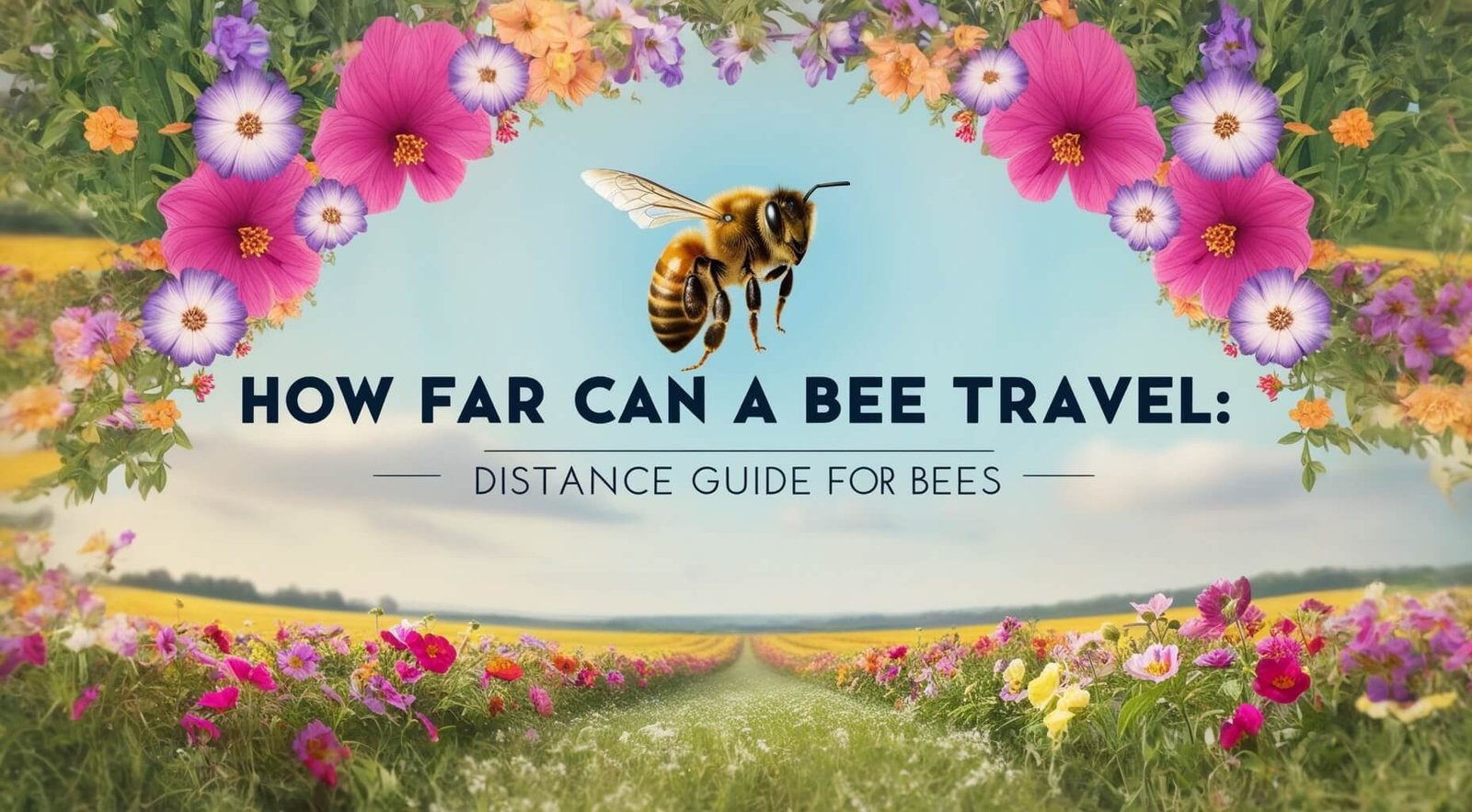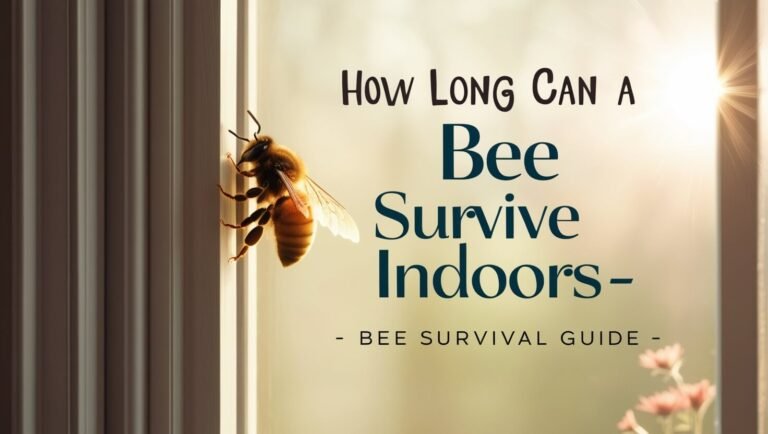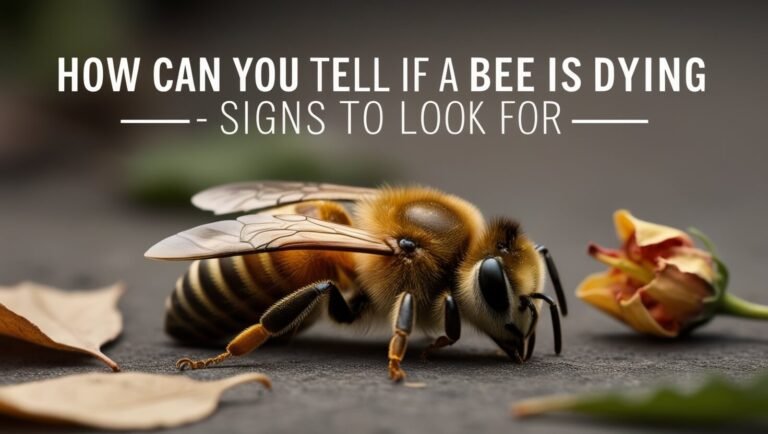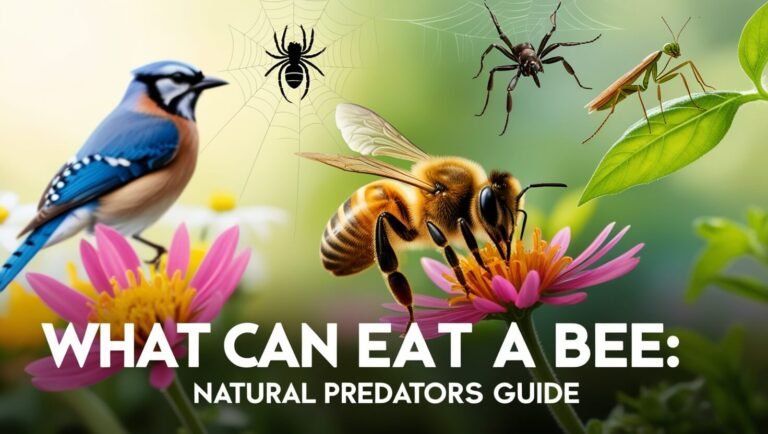How Far Can a Bee Travel: Distance Guide for Bees

Ever thought about how far a bee can go from its hive? The answer might amaze you. Honeybees, our hardworking pollinators, can fly up to 5 miles (8 kilometers) to find food. But, they can go even farther when they need to.
So, what makes a bee travel so far? And how long have they been known to fly? Let’s explore the amazing world of bee travel.
Average Flight Distances of Different Bee Species
Bees are fascinating creatures, each species showing unique foraging behaviors and travel patterns. From the busy honeybee to the solitary bee, their travel distances are quite remarkable.
Honeybee Travel Ranges
Honeybees often forage several kilometers from their hive. Most workers fly 600–800 meters to gather food. The mean foraging distance is about 2.3 km, with 9% of the colony’s foraging within 6 km.
In extreme cases, honeybees have traveled up to 13.5 km to find resources.
Bumblebee Flight Distances
Bumblebees, like the Bombus terrestris species, have a mean foraging distance of 267.2 meters. Nearly 40% of workers venture within 100 meters of the nest. Other bumblebee species, like B. pascuorum, forage over distances less than 312 meters.
B. terrestris may travel up to 625 meters. Most bumblebee species travel no more than 600-1,700 meters to find food.
Solitary Bee Movement Patterns
Solitary bee species have shorter foraging ranges, typically between 150–600 meters. This is because they focus on provisioning their individual nests, not a larger colony.
Bees, regardless of species, can travel impressive distances. They face many threats along the way. Knowing their average flight distances helps us understand their foraging behaviors and ecosystem health.
How Far Can a Bee Travel From Its Hive
Bees are amazing at finding their way back home. They can travel far to get nectar, pollen, and water. Honeybees have been known to go up to 13.5 kilometers (8.4 miles) from their hive.
In one study, half of the bees went over 6 km (3.7 miles). A quarter went beyond 7.5 km (4.7 miles). And 10% even went over 9.5 km (5.9 miles).
The longest homing distance bees can travel after being moved is between 6 km (3.7 miles) and 9.2 km (5.7 miles). This shows how skilled they are at finding their way back.
- The average distance a honeybee flies to collect nectar is 2 to 3 miles.
- The average distance a honeybee flies to collect pollen is 1 to 2 miles.
- Honeybees typically fly less than 1 mile to collect water.
Weather, food, and the health of the colony can affect how far bees can forage. Knowing how far bees can fly helps us understand their role in pollination. It also shows how important they are for plants in different places.
Factors Affecting Bee Flight Distance
The distance a bee can travel from its hive depends on many things. Weather, food availability, and the health of the colony are key. Knowing these helps us understand how bees navigate and forage.
Weather Conditions Impact
Weather greatly affects how far bees can fly. Honeybees prefer flying when it’s between 72-77°F. They won’t fly if it’s too cold or windy.
Mason bees, however, can fly even in the rain. This is different from honeybees.
Food Source Availability
Where and how much food is available affects bees’ flying. They choose their routes based on food quality and quantity. Studies show food is the main reason bees forage.
Colony Health Effects
The health of a bee colony also matters. Pesticides and other dangers can harm bees. This can make them fly less and pollinate less well.
Maximum Recorded Flight Distances
Bees are truly amazing flyers. They can travel incredible distances in search of food. Honey bees have been known to fly up to 13.5 km for nectar and pollen. But other bees can travel even farther.
The Euglossine bee, Euplasia surinamensis, has flown back to its hive from 23 km away. This is an incredible feat of navigation. It shows how some bees can cover long distances.
Other bees also show impressive flying skills. Stingless bees like Melipona fasciata and Melipona mandacaia can forage up to 2.4 km and 2.1 km from their nests. Medium-sized Meliponini bees can fly up to 1.7 km.
These amazing distances show how well bees have adapted to fly. Whether it’s the long flights of Euglossine bees or the impressive ranges of others, bees amaze us with their flying abilities.
Regional Differences in Bee Travel Patterns
Bee movement patterns change a lot between cities and countryside. In cities, bees face a variety of food sources but spread out. This makes their travel longer as they search the area. In the countryside, there’s more food in one place, but bees have to fly far to get to it.
Urban Environment Impact
Urban areas are tough for bees to move around in. They face buildings, roads, and other human-made things that block their way. To get back home, bees use dead reckoning. This method helps them track their path and find their hive.
Rural Foraging Behaviors
In rural places, bees don’t have to deal with as many barriers. But, they have to fly far to find food. Mountains or water can change where bees fly and how far they go. For example, bees fly around mountains to get back to their hive.
| Bee Movement Patterns | Urban Environment | Rural Environment |
|---|---|---|
| Food Source Availability | Diverse but scattered | Concentrated but distant |
| Travel Distances | Increased to navigate landscape | Longer flights between patches |
| Navigation Techniques | Dead reckoning to avoid obstacles | Navigational skills to bypass landscape features |
Bee Navigation Methods During Long-Distance Travel
Bees have amazing ways to navigate, letting them travel far from their hives. They search for nectar and pollen. Their navigation methods help them find their way back home.
Bees remember landmarks and skylines as they travel. They use these visual cues to find their way back. They also use the sun and polarized light to guide them, even on cloudy days.
Bees use a waggle dance to tell their friends where food is. The dance shows the direction of the food, helping the colony. This dance is key to their navigation.
Bees can even find their way using only polarized light in the sky. This skill helps them navigate, even without direct sunlight. It’s how they stay on course and find their hive, no matter the weather or terrain.
Bees’ navigation skills and homing ability let them travel far for resources. They always find their way back to their colonies. This shows how adaptable and resilient these pollinators are.
Seasonal Changes in Bee Travel Distance
Bees change how far they travel with the seasons. They adjust their foraging and flight to find food and deal with the environment.
Spring and Summer Patterns
In spring and summer, bees fly farther and forage more. This is because there’s plenty of nectar and pollen from flowers. They cover much more ground in summer than in spring.
Studies show bees fly up to 22 times farther in summer than in spring. This is a big change.
Fall and Winter Adjustments
In fall, bees fly less, covering about 1,275 meters on average. Winter is even tougher, with bees staying near the hive. This helps them save energy and keep the colony alive.
Some bees, like B. pensylvanicus sonorus, climb up to 1,000 meters daily in the desert. This shows how adaptable they are to finding food.
| Season | Mean Foraging Distance (meters) | Foraging Area (km²) |
|---|---|---|
| Spring | 493 | 0.8 |
| Summer | 2,156 | 15.2 |
| Fall | 1,275 | 5.1 |
Impact of Landscape Features on Bee Movement
The landscape around a bee’s hive greatly affects its flight and movement. Bees use natural and man-made features as guides during their searches for food.
Mountains, water, and buildings can be barriers or guides for bees. Studies show bees fly around big obstacles like mountains. They use these landmarks to stay oriented and find their way back home.
Bees also use familiar landmarks to break down long trips into smaller parts. This makes their navigation better. They focus on the color, size, and orientation of these landmarks. This helps them find food by matching what they see with their memories.
Landmarks can be close or far away, changing how bees see them. Close landmarks change a lot in size, while distant ones don’t. Bees can tell apart similar views, using recognizable cues.
Knowing how landscape features affect bee flight patterns and bee movement is key. It helps us create better environments for bees. This way, we can protect these important pollinators and keep their populations healthy.
Scientific Research on Bee Flight Range
Modern research on bee flight range uses advanced tracking technologies. This has given us a deeper look into how these important pollinators move. Tools like harmonic radar and RFID tags let researchers track bees without needing to watch them all the time.
Modern Tracking Methods
RFID tags have changed how scientists study bee flight patterns. These small devices track individual bees in real-time. This gives a lot of data on their foraging and long trips. Now, scientists can understand bee navigation and what affects their flight range better.
Key Research Findings
- Bees can stop using path integration when they see familiar landmarks. Instead, they use a mix of cues for navigation.
- Bees’ homing skills change based on where they are released. They can find their way back to the hive from far away.
- Global landmarks, like big landscape features, are key for bees on long trips. They help bees stay on course and find their way home.
These findings, from using bee tracking technology and bee flight research, have greatly increased our knowledge of bees. As we learn more about bee mobility, we get important info for conservation and farming.
Final Thoughts:
Bees can travel long distances, showing their amazing adaptability and importance in our ecosystems. They are key pollinators, helping plants and crops grow. Knowing how bees travel and pollinate is vital for saving our environment.
This article has shown how different bees fly and navigate. Honeybees, bumblebees, and solitary bees all have unique roles. Each species is crucial for our ecosystems’ balance.
Bees face many challenges like habitat loss and climate change. We must protect their habitats and support green farming. By understanding bees’ travel and pollination, we can help them thrive. This will keep our world healthy and strong for the future.
Popular Questions:
How far can honeybees travel from their hive?
Honeybees can fly up to 5 miles (8 kilometers) from their hive to find food. Sometimes, they go even farther, up to 7 miles (11 kilometers) or more, for nectar and pollen.
What is the average foraging distance for different bee species?
Honeybees often forage several kilometers from their nest. Most workers fly 600–800 meters to gather food. The average distance is 2.3 km, with 9% of foraging within 6 km.
Bumblebees, like Bombus terrestris, fly a mean distance of 267.2 m ± 180.3 m (max. 800 m). Solitary bees usually forage between 150–600 m, depending on the species.
What is the maximum recorded foraging distance for bees?
The farthest foraging distance varies by bee species. Honeybees have been recorded flying up to 13.5 km. Euglossine bees, specifically Euplasia surinamensis, return home from up to 23 km, carrying pollen from 14, 12, 20, and 23 km away.
How do weather conditions and food source availability affect bee flight distance?
Weather greatly affects bee flight distance. Temperature, wind speed, and rain impact their foraging range. Bees also adjust their distances based on the availability and quality of nectar and pollen.
How do landscape features influence bee movement and travel patterns?
Landscape features, like mountains or water, affect bees’ foraging routes and distances. Bees fly around obstacles, using dead reckoning to find their way back. Familiar landmarks help them navigate more accurately.
What navigation methods do bees use for long-distance travel?
Bees use landmarks, skyline panoramas, and the sun and polarized skylight as compasses. They integrate their flight paths and match visual cues with the environment.
How do bee travel distances change seasonally?
Bee travel distances change with the seasons. Spring and summer see more foraging and longer flights due to abundant food. Fall flights may be longer as food sources dwindle. Winter foraging is limited, with bees staying closer to the hive.
What are the key findings from modern research on bee flight range?
Recent studies using advanced tracking methods have shed light on bee navigation. Bees can suppress path integration with familiar landmarks and are flexible in their navigation strategies.




